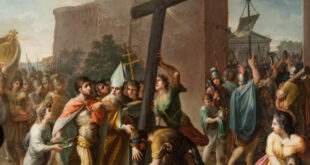“Be imitators of God, as beloved children, and walk in love, just as Christ also loved us and gave Himself up for us” (Ephesians 5:1–2)
Introduction
In times of noise, hyperactivity, and a constant search for immediate gratification, speaking of an austere life, hidden and fully surrendered to God may seem anachronistic or even incomprehensible. However, the human heart continues to long for the eternal, the absolute, for that which gives true meaning to life. In this context, the Rule of Carmel, born in the silence of the mountains in the 13th century and still alive in the hearts of those who embrace it, emerges as a beacon of spiritual light, a guide for anyone who desires to walk the path of holiness.
This article aims to present the Rule of Carmel not as a simple monastic document, but as an authentic way of life, deeply rooted in the Gospel and fully applicable to the Christian of today. We will delve into its history, theology, spirituality, and above all, how we can make it our own, even while living in the midst of the world.
1. Historical Origin: On the Mountain of the Lord
The Rule of Carmel arose at the dawn of the 13th century, a time marked by crusades, reforms, and spiritual restlessness. A group of hermits — possibly former crusaders — withdrew to Mount Carmel, in the Holy Land, near the spring of the prophet Elijah. They sought to live a life of continual prayer, penance, and radical poverty, inspired by the example of the prophet who, in the silence of the mountain, heard the voice of God as a “gentle whisper” (1 Kings 19:12).
At the request of these men, Saint Albert of Jerusalem, the Latin Patriarch of the Holy City, gave them a rule of life between 1206 and 1214 — brief, but deeply evangelical. This is the Rule of Carmel, which was later approved by the Church and served as the foundation for the Carmelite Order, both in its male and female branches.
2. Structure and Content of the Rule
The Rule of Carmel is surprisingly brief (only about twenty chapters), but its spiritual density is immense. Unlike other more legislative monastic rules, the Carmelite rule is profoundly biblical and spiritual.
Some of its essential elements are:
- Living in obedience to Jesus Christ: The Carmelite life is defined as an existence “in obedience to Jesus Christ,” which implies a radical following of the Master, even unto the cross.
- Continuous prayer: Life is oriented toward the assiduous meditation on the Word of God and unceasing prayer. The Rule commands to “meditate day and night on the law of the Lord.”
- Community life in charity: Although originally eremitical, Carmelite life is structured around fraternity, under the authority of a prior and with mutual love as its principle.
- Manual work and silence: Work is considered a means of sanctification, and silence a favorable environment for listening to God.
- Poverty and austerity: The rule requires radical renunciation of personal possessions and a sober lifestyle.
- Fasting and penance: Fasting is seen not only as mortification but as readiness of the heart for God.
All of this configures a life ideal centered on God alone (“solus cum Solo”), as Saint John of the Cross would say.
3. Spiritual Theology of the Rule of Carmel
a) Radical Christocentrism
Carmelite spirituality revolves around Jesus Christ, God made man, who loved us to the extreme. The Rule proposes a configuration with the crucified and glorious Christ. Every Carmelite — and by extension every Christian — is invited to “take up his cross daily and follow him” (cf. Luke 9:23), accepting the interior purification that comes with loving with an undivided heart.
b) Interior Life and Prayer
One of the most notable elements is the insistence on the interior life. Carmel has been the cradle of great mystics like Saint Teresa of Jesus, Saint John of the Cross, Saint Thérèse of the Child Jesus, and Saint Elizabeth of the Trinity. All of them draw from this wellspring: the soul becomes a dwelling place for God, and in that inner space, the mystical transformation is accomplished.
c) The Virgin Mary as Model
Carmel is, above all, the Order of the Virgin, and its Rule implicitly carries a total surrender to Mary, the Virgin of silence, of listening, and of availability. Mary appears as a model of contemplation and a sure guide to Christ. The Carmelite scapular is the visible sign of this spiritual alliance.
d) Prophetic Life and Mission
Inspired by the prophet Elijah, Carmelites are called to live a life that is a prophetic sign: poverty amidst consumerism, silence amidst noise, prayer amidst distraction, fidelity amidst confusion. This austere and hidden life possesses tremendous evangelizing power.
4. Relevance for the Modern World
The Rule of Carmel is not reserved only for cloistered religious. On the contrary, it offers a valid path of spirituality for all the faithful who wish to live their baptismal vocation more deeply. In a fragmented world, Carmelite spirituality offers:
- A path to interior unity
Through silence and prayer, the soul reconnects with its true center: God. This is especially necessary today, when stress, anxiety, and interior dispersion afflict so many. - An antidote to materialism
The austere life is not a rejection of things, but putting them in their proper place. Living with sobriety, without becoming enslaved by consumption, is more urgent today than ever. - A lifestyle centered on what is essential
Faced with the saturation of stimuli, the Rule invites us to “live with what is necessary,” seeking God in the ordinary and offering our hearts as divine dwelling places. - A prophetic witness in the world
To be a Christian today is, in a way, to be a prophet: to show with one’s life that God is enough. The witness of a soul that lives in silence, peace, and surrender has incalculable missionary value.
5. Practical Applications for Daily Life
How can we, everyday Christians, live the spirit of the Rule of Carmel?
a) Cultivate interior silence
Dedicate a moment each day to silence, without phone, without distractions — simply to be with God. It can be upon waking, before bed, or during a midday break.
b) Meditate on the Word of God
Read a Gospel passage and chew on it throughout the day: “Meditate day and night on the law of the Lord” is a simple and profoundly transformative practice.
c) Simplify your life
Review your consumption habits, your use of time, your attachments… What do I really need? What can I offer? Sobriety doesn’t impoverish — it enriches the soul.
d) Offer small sacrifices
Fast, renounce a craving, accept a hardship without complaining, perform a charitable act in secret… these are daily ways to live surrender.
e) Honor Our Lady of Mount Carmel
Pray the scapular devotion, consecrate yourself to the Virgin, invoke her intercession daily. This is to enter the school of Marian love, which leads us directly to Christ.
Conclusion: A Hidden Path Toward the Light
The Rule of Carmel is not a set of rigid norms but a path of freedom in God, a way of living according to the Spirit, a call to place Christ at the center of existence. Its beauty lies in its demands, yes — but also in its liberating power: whoever gives their heart to God receives everything.
As the Gospel reminds us: “Whoever loses his life for me and for the Gospel will save it” (Mark 8:35). The Carmelite life, though hidden, is a living testimony to this truth. Today, more than ever, we need souls who, like Mary and Elijah, live “in the presence of the living God” (1 Kings 17:1).
And you? Will you dare to enter this path of silence, austerity, and total love?






